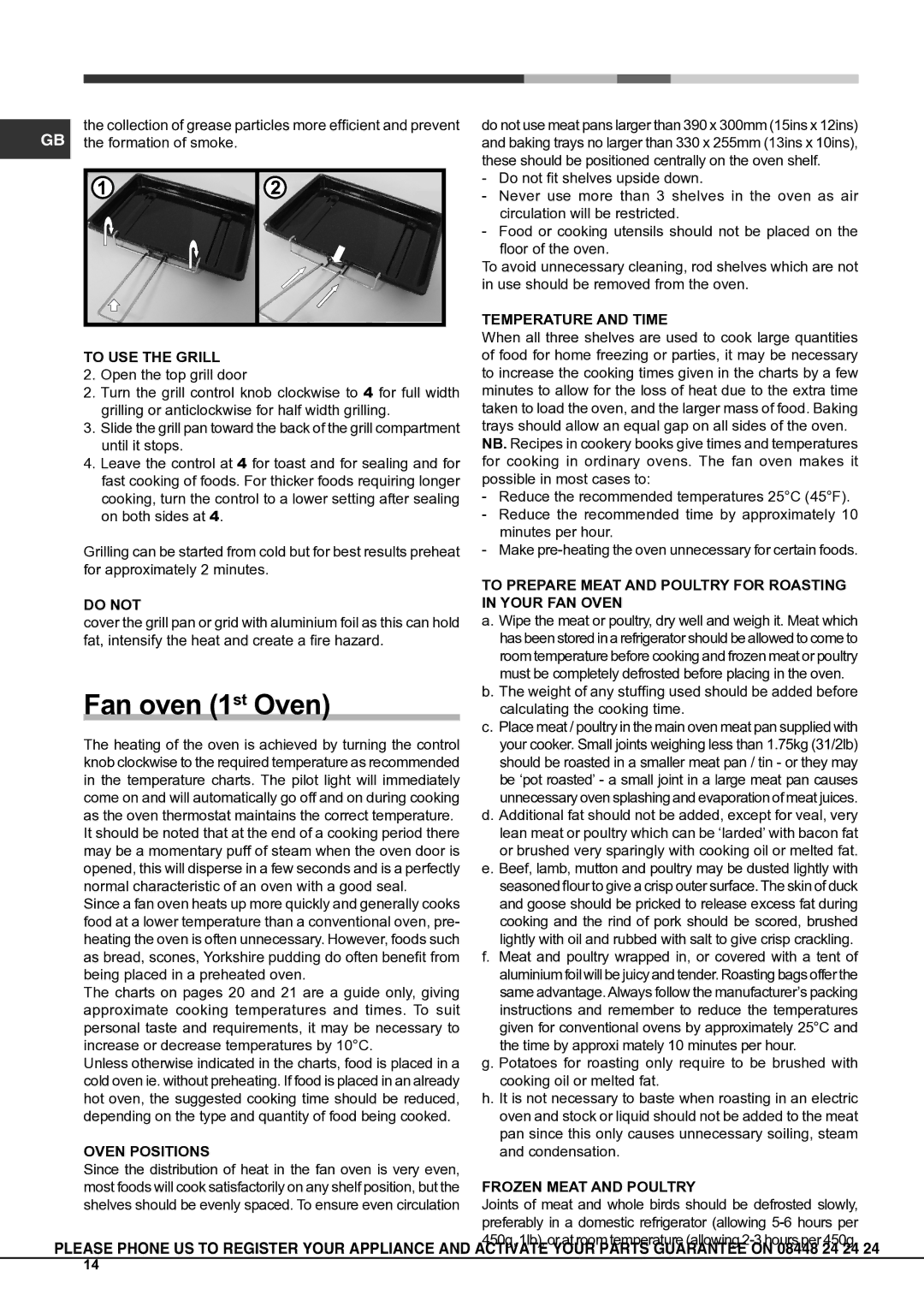TO USE THE GRILL
2. Open the top grill door
2. Turn the grill control knob clockwise to 4 for full width grilling or anticlockwise for half width grilling.
3. Slide the grill pan toward the back of the grill compartment until it stops.
4. Leave the control at 4 for toast and for sealing and for fast cooking of foods. For thicker foods requiring longer cooking, turn the control to a lower setting after sealing on both sides at 4.
Grilling can be started from cold but for best results preheat for approximately 2 minutes.
DO NOT
cover the grill pan or grid with aluminium foil as this can hold fat, intensify the heat and create a fire hazard.
Fan oven (1st Oven)
The heating of the oven is achieved by turning the control knob clockwise to the required temperature as recommended in the temperature charts. The pilot light will immediately come on and will automatically go off and on during cooking as the oven thermostat maintains the correct temperature. It should be noted that at the end of a cooking period there may be a momentary puff of steam when the oven door is opened, this will disperse in a few seconds and is a perfectly normal characteristic of an oven with a good seal.
Since a fan oven heats up more quickly and generally cooks food at a lower temperature than a conventional oven, pre- heating the oven is often unnecessary. However, foods such as bread, scones, Yorkshire pudding do often benefit from being placed in a preheated oven.
The charts on pages 20 and 21 are a guide only, giving approximate cooking temperatures and times. To suit personal taste and requirements, it may be necessary to increase or decrease temperatures by 10°C.
Unless otherwise indicated in the charts, food is placed in a cold oven ie. without preheating. If food is placed in an already hot oven, the suggested cooking time should be reduced, depending on the type and quantity of food being cooked.
OVEN POSITIONS
Since the distribution of heat in the fan oven is very even, most foods will cook satisfactorily on any shelf position, but the shelves should be evenly spaced. To ensure even circulation
the collection of grease particles more efficient and prevent
GB the formation of smoke.
do not use meat pans larger than 390 x 300mm (15ins x 12ins) and baking trays no larger than 330 x 255mm (13ins x 10ins), these should be positioned centrally on the oven shelf.
-Do not fit shelves upside down.
-Never use more than 3 shelves in the oven as air circulation will be restricted.
-Food or cooking utensils should not be placed on the floor of the oven.
To avoid unnecessary cleaning, rod shelves which are not in use should be removed from the oven.
TEMPERATURE AND TIME
When all three shelves are used to cook large quantities of food for home freezing or parties, it may be necessary to increase the cooking times given in the charts by a few minutes to allow for the loss of heat due to the extra time taken to load the oven, and the larger mass of food. Baking trays should allow an equal gap on all sides of the oven.
NB. Recipes in cookery books give times and temperatures for cooking in ordinary ovens. The fan oven makes it possible in most cases to:
-Reduce the recommended temperatures 25°C (45°F).
-Reduce the recommended time by approximately 10 minutes per hour.
-Make pre-heating the oven unnecessary for certain foods.
TO PREPARE MEAT AND POULTRY FOR ROASTING IN YOUR FAN OVEN
a.Wipe the meat or poultry, dry well and weigh it. Meat which has been stored in a refrigerator should be allowed to come to room temperature before cooking and frozen meat or poultry must be completely defrosted before placing in the oven.
b.The weight of any stuffing used should be added before calculating the cooking time.
c.Place meat / poultry in the main oven meat pan supplied with your cooker. Small joints weighing less than 1.75kg (31/2lb) should be roasted in a smaller meat pan / tin - or they may be ‘pot roasted’ - a small joint in a large meat pan causes unnecessary oven splashing and evaporation of meat juices.
d.Additional fat should not be added, except for veal, very lean meat or poultry which can be ‘larded’ with bacon fat or brushed very sparingly with cooking oil or melted fat.
e.Beef, lamb, mutton and poultry may be dusted lightly with seasoned flour to give a crisp outer surface. The skin of duck and goose should be pricked to release excess fat during cooking and the rind of pork should be scored, brushed lightly with oil and rubbed with salt to give crisp crackling.
f.Meat and poultry wrapped in, or covered with a tent of aluminium foil will be juicy and tender. Roasting bags offer the same advantage.Always follow the manufacturer’s packing instructions and remember to reduce the temperatures given for conventional ovens by approximately 25°C and the time by approxi mately 10 minutes per hour.
g.Potatoes for roasting only require to be brushed with cooking oil or melted fat.
h.It is not necessary to baste when roasting in an electric oven and stock or liquid should not be added to the meat pan since this only causes unnecessary soiling, steam and condensation.
FROZEN MEAT AND POULTRY
Joints of meat and whole birds should be defrosted slowly, preferably in a domestic refrigerator (allowing 5-6 hours per 450g, 1lb), or at room temperature (allowing 2-3 hours per 450g,
PLEASE PHONE US TO REGISTER YOUR APPLIANCE AND ACTIVATE YOUR PARTS GUARANTEE ON 08448 24 24 24

